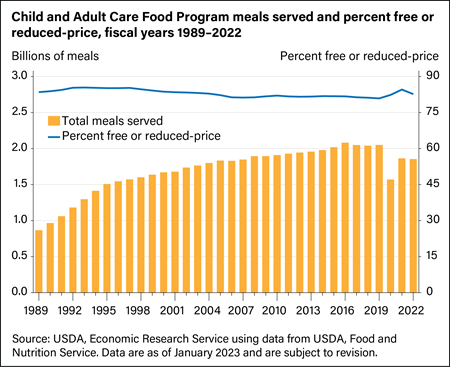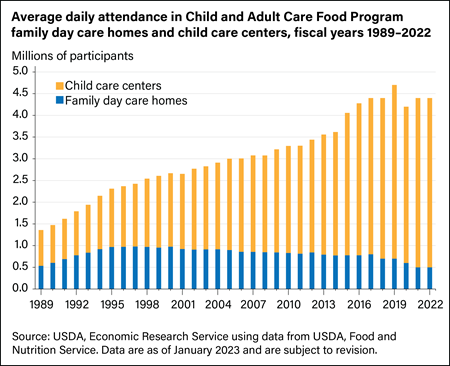
Child and Adult Care Food Program
The Child and Adult Care Food Program (CACFP) provides meals and snacks to children at child care centers, family day care homes, emergency shelters, and after-school programs, and to older or functionally impaired adults at adult day care centers. In fiscal year (FY) 2019 (before the Coronavirus (COVID-19) pandemic), approximately 4.7 million children and about 137,000 adults received CACFP meals and snacks on an average day. In that year, the program served a total of about 2.1 billion meals at a cost of $3.7 billion.
The onset of the pandemic in the second half of FY 2020 disrupted the provision of meals and snacks through the program by limiting the operation of many child and adult care providers. In response to these disruptions and to meet rising food needs during the pandemic, USDA issued waivers allowing for flexibilities in the implementation of the CACFP. To learn more about pandemic-era changes to the CACFP, please see:
- The Food and Nutrition Assistance Landscape: Fiscal Year 2020 Annual Report
- The Food and Nutrition Assistance Landscape: Fiscal Year 2021 Annual Report
- The Food and Nutrition Assistance Landscape: Fiscal Year 2022 Annual Report
- COVID-19 Working Paper: Filling the Pandemic Meal Gap: Disruptions to Child Nutrition Programs and Expansion of Free Meal Sites in the Early Months of the Pandemic
In FY 2020, CACFP averaged about 4.3 million child and adult participants daily and served nearly 1.6 billion total meals. In that year, total expenditures on the program amounted to $2.8 billion. Program participation, total meals served, and expenditures rebounded to pre-pandemic levels in FY 2021. In that year, daily participation among children and adults increased to an average of about 4.8 million and 1.9 billion total meals were served at a cost of $3.8 billion. In FY 2022, the program averaged about 4.6 million child and adult participants daily and served about 1.9 billion meals at a cost of $3.9 billion.
USDA's Food and Nutrition Service (FNS) administers the CACFP and reimburses participating child and adult care providers for the meals and snacks served. Children in a participating child care center from households with incomes:
- At or below 130 percent of the Federal poverty line can receive a free meal or snack.
- Between 130 and 185 percent of the Federal poverty line can receive a reduced-price meal or snack.
- Above 185 percent of the Federal poverty line can receive a low-cost, full-price meal or snack.
In day care homes, meals are reimbursed either at tier 1 or tier 2 rates. Tier 1 rates provide higher levels of reimbursement to day care homes in low-income areas or those in which the provider's household income is at or below 185 percent of the Federal poverty line. Meals served in day care homes to children eligible for free or reduced-price meals can also be reimbursed at tier 1 rates. Tier 2 rates provide lower levels of reimbursements to day care homes that do not meet the location or provider income criteria for tier 1 rates. Meals and snacks provided through CACFP can be especially important to working parents, playing a role in improving day care quality and making day care more affordable for recipients.
Over the past two decades, fewer children participated in the program through day care homes, dropping from 1 million in FY 2000 to nearly 700,000 in FY 2019. However, the number of children participating in CACFP through child care centers has grown—from 1.7 million children in FY 2000 to approximately 4 million in FY 2019. This growth resulted in an increase in total participation in CACFP, from 2.7 million children in FY 2000 to 4.7 million in FY 2019. These trends continued during the pandemic. In FY 2020, nearly 600 thousand children participated in CACFP through day care homes and about 3.6 million through child care centers. The number of children participating through day care homes declined further, to nearly 540 thousand in FY 2022, while the number participating through child care centers rose to 3.9 million.
A USDA, Economic Research Service report summarized research and found evidence that participation in CACFP by child care providers improves food security for households with children enrolled in the centers; participation also improves consumption of milk and vegetables. To learn more, please see:
As part of the changes required by Congressional reauthorization of the program in 2010, CACFP is allowed to provide suppers to children attending after-school programs in high-need areas, where at least 50 percent of children are eligible for free or reduced-price meals (see After-School Snacks and Meals). In addition, reauthorizing legislation required USDA's FNS to develop updated nutrition standards for CACFP meals and snacks that better reflect current Federal dietary guidance. Since 2017, CACFP centers and day care homes are required to meet updated standards—with meals that include a greater variety of vegetables and fruits, more whole grains, and less added sugar and saturated fat.
All figures are based on data available as of January 2023 and are subject to revision.
For information on updates to the program during the COVID-19 pandemic, see FNS Responds to COVID-19.
Additional studies and information about program eligibility requirements, benefits, and application processes are available from the Food and Nutrition Service Child Nutrition Programs web page.
Download chart data in Excel format
Download chart data in Excel format



